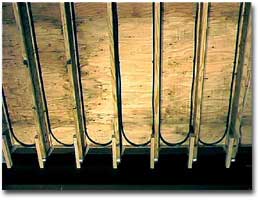

This page depicts how Under-Floor Heating works with the Preassembled Boiler Room in a Box™. Under floor heating is usually installed where you have access to the floor joists of a retrofit or new home. Under floor heating is used where you want to have your tile floor in your kitchen or bathroom heated or in your family room/den/addition where you have hardwood floors and would like to have a comfortable room where your feet aren't constantly cold.
We will cover how and when to use radiant underfloor heating and the benefits to using A.I.M. installs rather thes systems from our competitors.
The question that most people ask is "When should we use under floor heating/staple up and when should we use the Slimline baseboard panels?" You should use the Slimline baseboard when you are going to use thick carpeting with heavy padding. You should use the under floor heating system when you have tile or hardwood floors that are high traffic areas or where you don't want to see a baseboard panel.
The next question that you may ask is: What makes our under floor heating system different from others and why buy from AIM? Most people buy from people that they trust that know what they are talking about. We at A.I.M. have sold and installed radiant heating for over 24 years. We have found better, less expensive way, utilizing PEX-AL-PEX tubing nailed to the floor joist 1-2" down from the sub floor creating a heat pocket under the floor. Using our foil insulation to reflect the heat back into the floor, you can rest assure that you will never have cold feet again.
Why use A.I.M.'s Under-floor vs. heat transfer plates. Some other companies try to sell you something called heat transfer plates. Heat transfer plates are mounted directly to the subfloor, these plates have channels through them to hold tubing in place. The tubing carries hot water through the plate and dispenses it through the floor. If you staple the tubing directly to the subfloor you can get what is called "Striping." Striping is when you see dark lines through your hardwood or tile floors. This occurs because the tubing with hot water heats up the section of your floor directly above to a temperature that is TOO HOT causing your floor to produce stripes.
When you buy from A.I.M. Radiant Heating you get the quality and expertise you require for installing your next under-floor radiant heating system. We will help you through the process, not just send you installation instructions with equipment. We want to sell you a complete system, our Boiler Room in a Box™ and the under floor tubing?
Why? Because we know it works!!! We have delivered this system to hundreds of satisfied customers. See how we installed the under floor system below. If you have questions or concerns about the installation process, call us and we will be happy to step you through it. A.I.M. is proud to announce that we now have a step-by-step video for this installation process.

Installing your in the floor system doesn't have to be difficult. Insulation is a critical part of your radiant heating installation, specifically your under-floor installation.
What is Reflective Insulation?
Reflective insulation is available in rolls of various widths and lengths. Two outer layers of aluminum foil reflect 97% of radiant heat. Each layer of foil is bonded to a tough layer of polyethylene for strength. Two inner layers of insulating bubble pack resist conductive heat flow while a center layer of polyethylene gives A.I.M.’s Reflective insulation high reliability and strength.
How Does it Work?
 |
 |
| House with Reflectix® | House without Reflectix® |
Reflective insulation reflects the sun's rays in the hot summer months. It also retains interior heat and helps to eliminate potentially damaging ice dams during the winter months.
Radiant heat, the major source of heat flow, is energy in the form of infrared waves. It travels at the speed of light, even through a vacuum, and is either transmitted through, absorbed into, or reflected by any material it contacts. Air, water and glass, for example, transmit visible light in varying degrees. A white surface, such as snow, reflects it; and a black surface absorbs it.
Reflective Insulation reflects up to 97% of the radiant energy striking its surface.
Why should you insulate under the slab or under your floor? Installing heat without insulation underneath is not a good idea; the price of the insulation is usually saved in energy cost in one season
Floor heat loss: 25% of your heat loss is downwards, so if you insulate under your slab or floor, you could save 25 % of your heating cost.
Remember opposites attract.
Warm air is attracted to cold and vice versa.
Think about heat for a second ... heat does not rise
Using a foil faced insulation will reflect the radiant heat back to where you need it most, within your home. Placing reflective insulation under the floor allows you to put the heat where you want it, allowing you to save money.
Please check back as we will provide you with detailed installation directions for under-floor heating installations.




